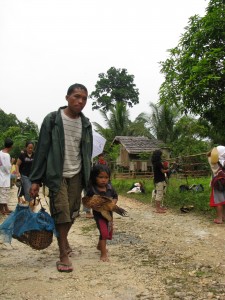 The Philippines ranks among the world’s most disaster-prone countries. It is highly prone to natural disasters, particularly typhoons, floods, landslides, volcanic eruptions, earthquakes, and tsunamis, lying as it does in the typhoon belt, in the active volcanic region known as the “Pacific Ring of Fire,” and in the geologically unstable region between the Pacific and Eurasian tectonic plates.
The Philippines ranks among the world’s most disaster-prone countries. It is highly prone to natural disasters, particularly typhoons, floods, landslides, volcanic eruptions, earthquakes, and tsunamis, lying as it does in the typhoon belt, in the active volcanic region known as the “Pacific Ring of Fire,” and in the geologically unstable region between the Pacific and Eurasian tectonic plates.
Aside from the natural disasters that reap an especially heavy human toll each year, thousands are also displaced by human-made disasters like armed conflict and development aggression. The intensifying effect of climate change also aggravates the already burdened citizens with the worsening economic instability worldwide.
Given this reality, the urgency for a comprehensive disaster management system and program is paramount.
Unfortunately, what we currently have in so far as government response is concerned is a national coordinating committee which as the name implies coordinates and meets only when a typhoon is about to strike the country. At the local level, effectiveness of the said structure is uneven with some focused only on the release of their calamity funds which later on became a source of corruption. Only a few exceptional cases led by the local disaster committees were able to go beyond their limited resources and muster the heroic volunteerism of the ordinary citizen.
While we commend the initiatives of enacting the Philippine Disaster Risk Management Act of 2008, we at the CDRC, together with our network of regional centers throughout the country, are pushing for a comprehensive and pro-people disaster management approach that will truly address the people’s needs.
First, a comprehensive disaster management bill has to adequately address the root causes of people’s vulnerabilities to disasters. The people’s poor economic condition only aggravates their situation during disasters. The poor are the most vulnerable sector when calamities strike, making it imperative to address poverty in disaster management.
Second, a comprehensive disaster management bill has to rely on building people’s capacities toward attaining disaster-resiliency through the community-based disaster management approach. It should highlight a proactive disaster management scheme, giving emphasis on people’s participation, prioritizing the most vulnerable groups, families, and people in the community. It should adopt risk reduction measures which are community-specific and enhance the existing coping mechanisms and capacities within the community. It should recognize the supporting and facilitating role of the less vulnerable sectors. It should be linked with the overall development framework. Its efforts should strengthen the people’s organizations at the grassroots level and provide positive conditions for the poorest of the poor to be organized as disaster committees on the level of their communities.
Third, the bill should also define comprehensive and concrete disaster management programs and services that focus not only during the relief and emergency phases but also more importantly on the pre and post calamity phases of disasters. It should provide a comprehensive, all-hazard, multi-sectoral, inter-agency and community-based approach to disaster risk reduction emphasizing on disaster prevention, mitigation, preparedness, response and rehabilitation. In addition, this bill should be bold enough to protect the majority of the Filipinos who comprise the most vulnerable sectors all the necessary protections from all form of deprivations and exploitation from both internal and external aggressors who hide under the title of development projects and recite the all too worn out formula of “free market forces and considerations.”
Fourth, any bill which would address disaster in order to be truly effectively managed and implemented should set up machinery which would be free from the influence and depredations of politics and any undue influence of religion, gender and race. In order to guarantee this, an independent body of civilian led and citizenry-based machinery should be set-up at the national level and organize up to the level of the barangays.
Since armed conflict is turning to be one of the major human-made disaster concerns – it is but appropriate to separate the efforts of the military and police to attend to disasters as part of their civil-military operations from that of a truly independent and “neutral” effort. In addition, the military and police in turn could be well utilized on the more urgent and technical work of rescue where their expertise could be put to best use.
Of course, the machinery we have in mind though independent should be within the ambit of government and promote the values and principles of the latter as enshrined in the constitution. In fact, the Department of Social Welfare and Development and the National Anti Poverty Commission could effectively run this machinery which could be in the form of a commission or whatever this august body may deem more appropriate.
In lieu of the military and police forces, the efforts of the civilian body could enlist the participation of established religions and churches who had put up their unblemished reputation on helping the poor.
Without imposing, the bill should be able to monitor efforts of other NGOs and corporate entities and provide an effective venue for pooled resources and efforts based on voluntary cooperation.
And in the very end, the effectiveness of this “disaster bill” would be proven its real worth on the day when it shall conclude that there is not can you get rid of herpes much more work for it to do as the conditions both natural and societal have improved to a point that no major danger or vulnerability is left for it to attend to on a full time basis. This is a dream all right but would be sufficient to guide the course of action of any individual, group, institution or organization who would like to address the issue of disaster. #
